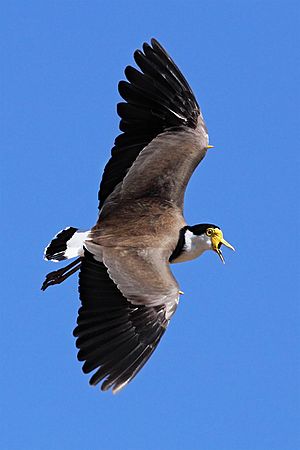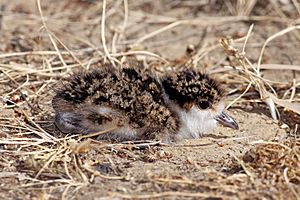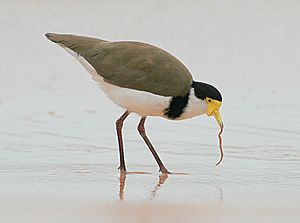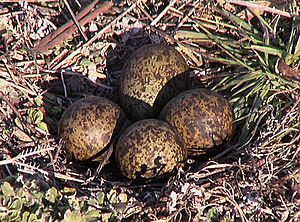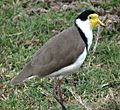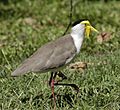Masked lapwing facts for kids
Quick facts for kids Masked lapwing |
|
|---|---|
 |
|
| V. m. miles | |
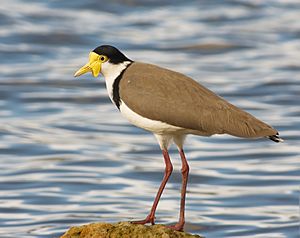 |
|
| V. m. novaehollandiae | |
| Conservation status | |
| Scientific classification | |
| Genus: |
Vanellus
|
| Species: |
miles
|
| Subspecies | |
|
|
| Synonyms | |
|
Hoplopterus miles (Boddaert, 1783) |
|
The masked lapwing (Vanellus miles) is a large, easily seen bird. It lives in Australia, New Zealand, and New Guinea. This bird spends most of its time on the ground, looking for food like insects and worms. It also makes many different sounds. You can often find it in open fields in Australia. During nesting season, it's famous for swooping down to protect its home.
People sometimes call this bird the masked plover or spur-winged plover. However, lapwings are a different group of birds from plovers. There are two main types, or subspecies, of the masked lapwing. One is called V. m. miles. The other is V. m. novaehollandiae, which lives in the south. This southern type has black marks on its shoulder and chest. Some people even think it's a separate species called the black-shouldered lapwing.
Contents
Bird Names: Understanding Masked Lapwing Taxonomy
The masked lapwing was first described by a French scientist named Georges-Louis Leclerc, Comte de Buffon in 1781. Another scientist, Pieter Boddaert, gave it the scientific name Tringa miles in 1783. The name Vanellus comes from a Latin word meaning "winnowing" or "fan," which describes how the bird moves its wings. The word miles means "soldier" in Latin. This might refer to its brave behavior.
There are two main types of masked lapwings:
- V. m. miles (Boddaert, 1783): This type lives in coastal New Guinea, the Aru Islands, and northern Australia.
- V. m. novaehollandiae Stephens, 1819: This type lives in southern Australia and New Zealand. It used to be called the spur-winged plover.
Some bird experts consider V. m. novaehollandiae to be its own species, the black-shouldered lapwing. However, these two types can still breed together in some parts of Australia.
What Does a Masked Lapwing Look Like?
The masked lapwing is the biggest bird in its family, Charadriidae. It is about 30 to 37 cm (12 to 15 in) long. Its wings can spread out 75–85 cm (30–33 in) wide. Each wing has a bright yellow spur on it, like a small spike.
The northern type (V. m. miles) weighs about 191–300 g (6.7–10.6 oz). It has an all-white neck and large yellow skin flaps called wattles on its face. The male has a clear "mask" pattern and bigger wattles.
The southern type (V. m. novaehollandiae) is larger, weighing about 296–412 g (10.4–14.5 oz). It has a black stripe on its neck and smaller wattles. People in Australia and New Zealand often call this one the spur-winged plover.
These birds make many different sounds, day or night. They have warning calls, loud defense calls, and calls for their young. Because they live on the ground, they are always alert. Even when resting, they never fully sleep.
Where Do Masked Lapwings Live?
Masked lapwings usually live near wetlands and other open, wet places. But they can live in dry areas too. You might also find them on beaches. The southern type, Vanellus miles novaehollandiae, naturally spread to Southland, New Zealand in the 1930s. Now, it lives all over New Zealand.
Masked Lapwing Behavior and Life Cycle
In summer and autumn, masked lapwings are usually shy. But during nesting season, they become very brave. They will build nests almost anywhere open, like parks, school fields, or even parking lots. They can be a problem at airports because they don't like to leave their nests, even for large planes. This can cause bird strikes.
Nesting usually starts after June 21st. The parent birds protect their territory from anyone who comes too close. They do this by:
- Calling loudly.
- Spreading their wings wide.
- Swooping down fast and low.
- Hitting intruders with their feet.
- Attacking animals with the yellow spur on their wing.
The bird might also pretend to have a nest somewhere else to trick predators. Or it might hop on one leg to distract a predator from its real nest or chicks. They seem to use different calls to guide their chicks. Long calls might mean "come closer," while a single chirp might mean "move away."
There's a common myth that the spur can inject poison, but this is not true. This myth might come from how fiercely they protect their nests. They attack other birds, cats, and dogs most often. Once the chicks are about 60% grown (after 2-3 months), the attacks become less common. They rarely strike humans. Sometimes a bird might hurt its wing during an attack, but it usually heals.
Some masked lapwings living in cities might not be able to raise their young successfully. This is because of many disturbances from pets, people, and cars. You often see two birds together, a male and a female, who look very similar. Sometimes, you can see them in groups, especially when they are feeding on coastlines.
A chick becomes fully grown after 4 to 5 months. It often stays with its parents for 1 to 2 years. This means you might see family groups of 3 to 5 birds nesting together. Masked lapwings can live for about 16 years.
These birds spend a lot of time on the ground. They search for worms and insects to eat.
Gallery
See also
 In Spanish: Avefría militar para niños
In Spanish: Avefría militar para niños



